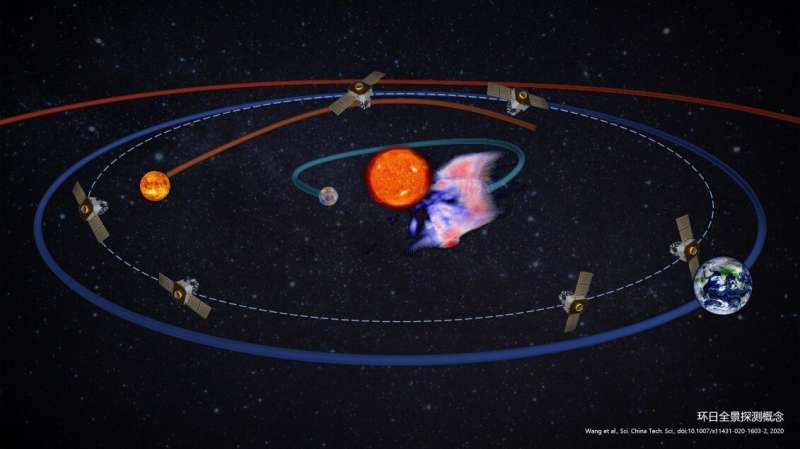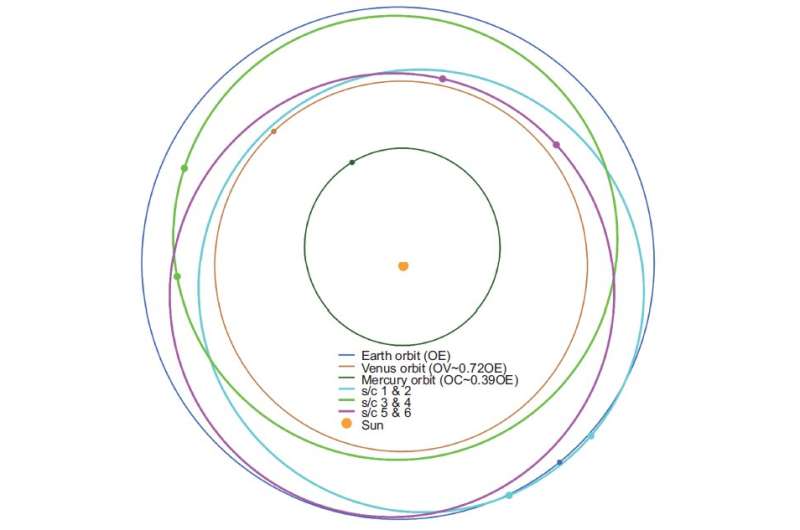A conceptual map of the Solar Ring mission. Credit: ©Science China Press
With the development of science and technology, human activity has expanded from land, sea and sky to space and other planets. In the near future, deep space and other terrestrial planets will become the next main territory of humanity. The Sun is the nearest star in the universe. It affects the (interplanetary) space of our planets in many time scales. Thus, observing and understanding solar activity and its evolution in interplanetary space and its influence on the space environment of planets is one of the necessary capabilities for us to enter deep space and expand our territory.
Recently, Professor Wang Yuming and his team from the University of Science and Technology of China, in collaboration with teams from Purple Mountain Observatory of the Chinese Academy of Sciences (CAS), Innovation Academy for Microsatellites of CAS, Shandong University, and the University of CAS, proposed a new concept of space exploration for understanding Sun and the inner heliosphere, which was published online in Science China Technological Sciences.
This concept for the first time proposes to deploy six spacecraft, grouped in three pairs, in three elliptical orbits between the earth and Venus around the Sun to observe and study the Sun and the inner heliosphere from a 360-degree perspective. The separation angle between two spacecraft in each group is about 30 degrees, and that between every two groups is about 120 degrees. Through this configuration, the mission will be able to image the vast area from the photosphere to the inner heliosphere with high resolution, and perform the in situ measurements. Three unprecedented capabilities will be established: (1) determine the photospheric vector magnetic field without ambiguity, (2) provide 360-degree maps of the Sun and the inner heliosphere, and (3) resolve solar wind structures at multiple scales and multiple longitudes. With these capabilities, the Solar Ring mission aims to address the origin of the solar cycle, the origin of solar eruptions, the origin of solar wind transients and the origin of severe space weather events.
The preliminarily designed three elliptical orbits of the Solar Ring mission. Credit: ©Science China Press
In order to achieve these scientific objectives, researchers suggest the following science payloads equipped on the six spacecraft: a spectral imager for magnetic field and helioseismology; a multi-band imager for EUV emissions; a wide-angle coronagraph; a radio investigator; a flux-gate magnetometer; a solar wind plasma analyzer; and a high-energy particle detector. It is preliminarily estimated that the total mass of the payloads on each spacecraft will be less than 110 kg; the power consumption will be no more than 180 W; and the peak data transmission rate will be about 52.06 Mbps.
Long March 3A or Long March 3B can be used to deploy the spacecraft in three launches by using one rocket-two spacecraft technology. The deployment period and the selection of the launch vehicle depend on the orbital parameters. The most challenging difficulty in the whole task is data transmission. In the traditional communication mode, the data transmission rate is about 5 Mbps at a distance of 0.25 AU (the average distance between the Sun and Earth is 1 AU) away from the Earth, and it will decrease to as low as 70 kbps at a distance of 2 AU. This data transmission rate is far lower than the desired scientific demand. To solve or relieve this problem, we either reduce the data rate by enhancing the capability of the onboard data processing, compression and storage and decreasing the sampling frequency, or develop more efficient techniques for deep space communication, e.g., laser communication.
The mission has a long implementation period and high cost, but its scientific and application prospects are significant. It can be implemented in three phases, with two spacecraft deployed in each phase. The successful implementation of any stage can bring great progress in detection ability and scientific research; at the same time, the design idea of grouping holds out the prospect and possibility of international cooperation. The successful accomplishment of the mission will greatly advance our understanding of the Sun and the interplanetary space environment surrounding our planets, so as to enhance our capability to enter deep space and expand into it.
More information: YuMing Wang et al, Concept of the solar ring mission: Overview, Science China Technological Sciences (2020). DOI: 10.1007/s11431-020-1603-2
Provided by Science China Press

























